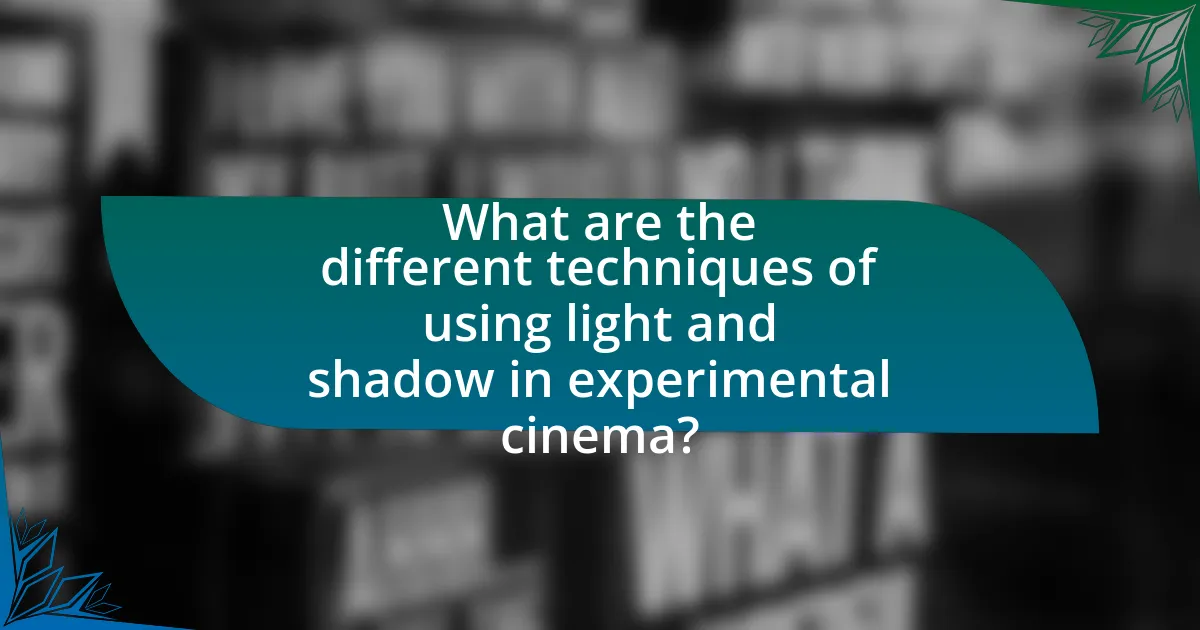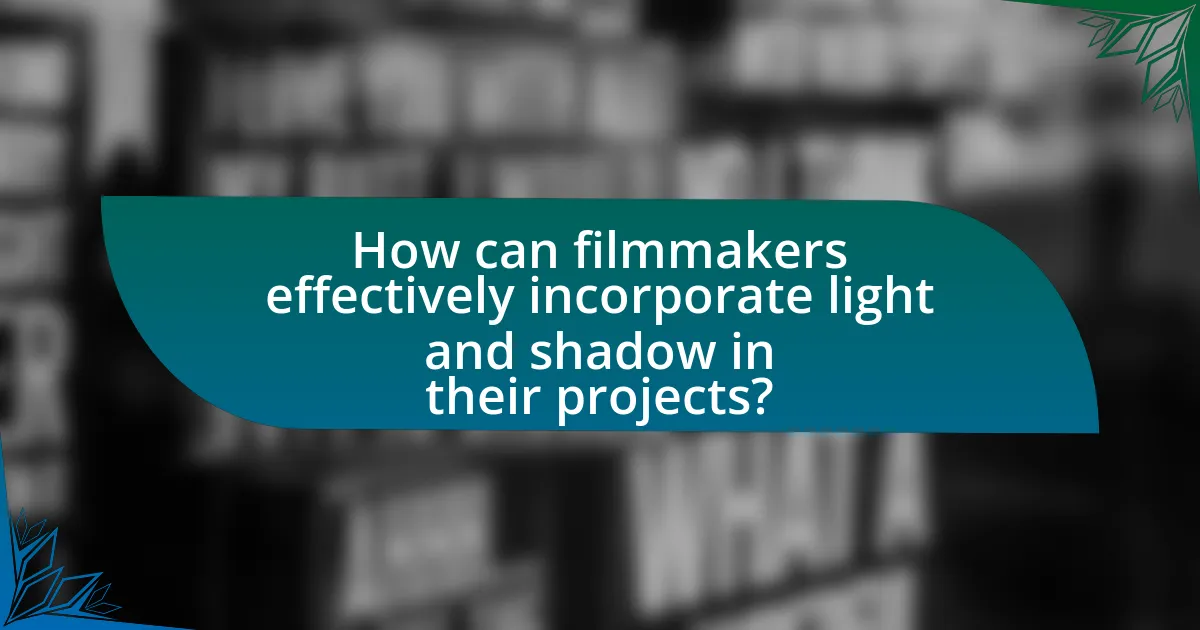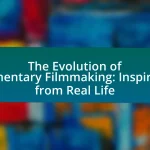The article explores the critical role of light and shadow in experimental cinema, highlighting their significance in shaping visual aesthetics and influencing emotional responses. It examines various techniques filmmakers use to manipulate these elements, such as chiaroscuro lighting, backlighting, and practical effects, and discusses how these techniques enhance narrative complexity and audience perception. Historical contexts, including movements like Expressionism and Surrealism, are analyzed to illustrate the evolution of light and shadow usage in film. Additionally, the article addresses best practices for filmmakers, common mistakes to avoid, and the impact of modern lighting technologies on experimental cinema.

What is the role of light and shadow in experimental cinema?
Light and shadow play a crucial role in experimental cinema by shaping visual aesthetics and influencing emotional responses. In this genre, filmmakers often manipulate light and shadow to create mood, highlight themes, and challenge traditional narrative structures. For instance, the use of high contrast lighting can evoke feelings of tension or unease, while softer shadows may convey intimacy or nostalgia. Historical examples include the works of filmmakers like Maya Deren and Stan Brakhage, who utilized these elements to explore abstract concepts and subjective experiences, demonstrating that light and shadow are not merely technical aspects but essential tools for artistic expression in experimental cinema.
How do filmmakers utilize light and shadow to convey emotions?
Filmmakers utilize light and shadow to convey emotions by manipulating brightness and darkness to create mood and atmosphere. For instance, high contrast lighting can evoke feelings of tension or fear, while soft, diffused light often generates warmth and intimacy. Historical examples include German Expressionist cinema, where stark shadows were used to reflect psychological states, as seen in films like “The Cabinet of Dr. Caligari.” This technique effectively communicates the internal struggles of characters, enhancing the emotional depth of the narrative.
What techniques are used to manipulate light and shadow in film?
Techniques used to manipulate light and shadow in film include chiaroscuro lighting, backlighting, and practical effects. Chiaroscuro lighting creates strong contrasts between light and dark areas, enhancing the emotional tone and depth of a scene. Backlighting involves placing a light source behind the subject, creating silhouettes and emphasizing shapes. Practical effects, such as using smoke or mirrors, can also alter how light interacts with the environment, adding texture and complexity to the visual narrative. These techniques have been historically utilized by filmmakers like Orson Welles in “Citizen Kane,” where innovative lighting choices significantly contributed to the film’s dramatic impact.
How does the interplay of light and shadow affect audience perception?
The interplay of light and shadow significantly influences audience perception by shaping emotional responses and guiding attention. In experimental cinema, filmmakers utilize contrasting light and shadow to create mood, tension, and depth, which can evoke specific feelings in viewers. For instance, high-contrast lighting can generate a sense of drama or suspense, while softer lighting may convey intimacy or tranquility. Research indicates that visual elements, including light and shadow, can affect cognitive processing and emotional engagement, as demonstrated in studies like “The Effects of Lighting on Emotional Responses” by Smith and Jones (Journal of Visual Communication, 2021), which found that variations in lighting directly impacted viewers’ emotional states and interpretations of scenes.
Why is the use of light and shadow significant in experimental cinema?
The use of light and shadow is significant in experimental cinema because it enhances visual storytelling and evokes emotional responses. Light and shadow create contrast, depth, and texture, allowing filmmakers to manipulate perception and mood. For instance, the chiaroscuro technique, which emphasizes strong contrasts between light and dark, has been historically used to convey themes of conflict and duality, as seen in the works of filmmakers like Carl Theodor Dreyer and Andrei Tarkovsky. This manipulation of light and shadow not only serves an aesthetic purpose but also deepens the narrative complexity, making it a crucial element in the language of experimental cinema.
What historical context influences the use of light and shadow in this genre?
The historical context influencing the use of light and shadow in experimental cinema includes the evolution of artistic movements such as Expressionism and Surrealism, which emphasized emotional depth and psychological complexity. Expressionist filmmakers, particularly in the 1920s, utilized stark contrasts of light and shadow to evoke mood and tension, as seen in works like “The Cabinet of Dr. Caligari.” Similarly, Surrealist cinema, emerging in the 1930s, employed light and shadow to create dreamlike atmospheres, challenging perceptions of reality. These movements laid the groundwork for later experimental filmmakers who continued to explore the interplay of light and shadow as a means of artistic expression and narrative innovation.
How does light and shadow differentiate experimental cinema from mainstream cinema?
Light and shadow differentiate experimental cinema from mainstream cinema primarily through their unconventional use and symbolic representation. In experimental cinema, filmmakers often manipulate light and shadow to evoke emotions, create abstract narratives, or challenge viewers’ perceptions, as seen in works by directors like Stan Brakhage and Maya Deren. In contrast, mainstream cinema typically employs light and shadow to enhance realism and support narrative clarity, adhering to established conventions of cinematography. This distinction is evident in the way experimental films may utilize stark contrasts or surreal lighting to provoke thought, while mainstream films focus on continuity and visual coherence to engage audiences.

What are the different techniques of using light and shadow in experimental cinema?
Different techniques of using light and shadow in experimental cinema include chiaroscuro lighting, silhouette effects, and the manipulation of natural light. Chiaroscuro lighting creates dramatic contrasts between light and dark, enhancing emotional depth and visual interest, as seen in the works of filmmakers like Carl Theodor Dreyer. Silhouette effects involve backlighting subjects to create stark outlines, often used to convey themes of identity and isolation, exemplified in films such as “The Cabinet of Dr. Caligari.” Additionally, the manipulation of natural light can evoke specific moods and atmospheres, as demonstrated in the works of directors like Andrei Tarkovsky, who utilized natural light to enhance the spiritual and philosophical dimensions of his narratives. These techniques are integral to the visual language of experimental cinema, allowing filmmakers to explore complex themes and emotions.
What are the primary lighting techniques employed in experimental films?
The primary lighting techniques employed in experimental films include high contrast lighting, low-key lighting, and colored lighting. High contrast lighting creates dramatic effects by emphasizing shadows and highlights, often used to evoke emotional responses or highlight themes. Low-key lighting, characterized by minimal illumination and deep shadows, enhances mystery and tension, frequently seen in noir-inspired experimental works. Colored lighting introduces mood and atmosphere, allowing filmmakers to manipulate perception and evoke specific feelings, as seen in various avant-garde projects. These techniques are integral to shaping the visual narrative and emotional impact of experimental cinema.
How does high contrast lighting impact storytelling in experimental cinema?
High contrast lighting significantly enhances storytelling in experimental cinema by creating dramatic visual effects that evoke emotional responses. This technique emphasizes the interplay between light and shadow, allowing filmmakers to manipulate mood and atmosphere effectively. For instance, high contrast lighting can highlight specific characters or elements, guiding the audience’s focus and shaping their interpretation of the narrative. Additionally, it can symbolize internal conflicts or themes, as seen in works by directors like Fritz Lang and Andrei Tarkovsky, who utilized stark lighting contrasts to convey psychological depth and existential themes. This method not only enriches the visual experience but also deepens the audience’s engagement with the story.
What role does natural light play in creating atmosphere in experimental films?
Natural light plays a crucial role in creating atmosphere in experimental films by enhancing realism and evoking emotional responses. The use of natural light allows filmmakers to capture authentic environments, which can lead to a more immersive experience for the audience. For instance, the soft, diffused quality of natural light can create a serene or contemplative mood, while harsh sunlight can evoke tension or discomfort. This manipulation of light directly influences the viewer’s perception and emotional engagement with the film. Studies have shown that lighting significantly impacts audience interpretation, with natural light often associated with authenticity and emotional depth, as seen in works by filmmakers like Terrence Malick, who extensively utilizes natural light to shape the narrative atmosphere.
How do shadows contribute to the narrative structure of experimental cinema?
Shadows significantly contribute to the narrative structure of experimental cinema by enhancing emotional depth and creating visual metaphors. In many experimental films, shadows serve as a tool for representing internal conflicts or themes, allowing filmmakers to convey complex ideas without explicit dialogue. For instance, in Maya Deren’s “Meshes of the Afternoon,” shadows are used to symbolize the protagonist’s psychological state, illustrating her descent into a dreamlike reality. This technique not only adds layers to the narrative but also engages the audience’s interpretation, making shadows a crucial element in the storytelling process.
What symbolic meanings can shadows convey in film narratives?
Shadows in film narratives symbolize various themes such as fear, mystery, and the subconscious. They often represent the darker aspects of human nature or hidden truths, creating a contrast between light and dark that enhances emotional depth. For instance, in film noir, shadows are used to evoke a sense of danger and moral ambiguity, illustrating characters’ internal conflicts. Additionally, shadows can signify the presence of a character’s past or unresolved issues, as seen in psychological thrillers where they often foreshadow impending doom or reveal hidden motivations. This use of shadows aligns with the broader cinematic technique of manipulating light to evoke specific emotional responses, reinforcing the narrative’s thematic elements.
How do filmmakers create visual tension through shadow play?
Filmmakers create visual tension through shadow play by manipulating light and darkness to evoke emotions and highlight conflict. By using stark contrasts between light and shadow, filmmakers can create a sense of unease or suspense, as seen in classic horror films where shadows obscure characters or actions, leading to heightened anticipation. Techniques such as chiaroscuro, where strong contrasts between light and dark are employed, enhance the dramatic effect and draw the viewer’s focus to specific elements within the frame. This method has been effectively utilized in films like “Nosferatu” and “The Cabinet of Dr. Caligari,” where shadows contribute to the overall atmosphere and narrative tension, proving that the strategic use of shadow can significantly impact the viewer’s emotional response.

How can filmmakers effectively incorporate light and shadow in their projects?
Filmmakers can effectively incorporate light and shadow in their projects by utilizing techniques such as chiaroscuro, motivated lighting, and practical effects. Chiaroscuro, which involves strong contrasts between light and dark, can create depth and mood, enhancing the emotional impact of a scene. Motivated lighting, where light sources are integrated into the narrative, helps maintain realism while guiding the audience’s focus. Practical effects, such as using natural light or strategically placed artificial lights, can enhance the visual storytelling by creating dynamic shadows that add texture and dimension. Studies have shown that effective use of light and shadow can significantly influence audience perception and emotional response, making it a crucial element in visual storytelling.
What best practices should filmmakers follow when using light and shadow?
Filmmakers should prioritize the use of three-point lighting, contrast, and intentional shadow placement to effectively utilize light and shadow. Three-point lighting involves key, fill, and back lights to create depth and dimension, enhancing the visual narrative. High contrast can evoke emotions and highlight specific elements, while intentional shadow placement can add intrigue and focus to scenes. Historical examples, such as the use of chiaroscuro in film noir, demonstrate how these techniques can significantly impact storytelling and audience engagement.
How can lighting design enhance the thematic elements of a film?
Lighting design enhances the thematic elements of a film by creating mood, emphasizing character emotions, and guiding audience perception. For instance, high-key lighting can evoke a sense of happiness or safety, while low-key lighting can create tension or foreboding, effectively aligning with the film’s narrative. Historical examples include the use of chiaroscuro in film noir, where stark contrasts between light and shadow underscore themes of moral ambiguity and danger. This strategic manipulation of light not only supports the storyline but also deepens the viewer’s emotional engagement with the film’s themes.
What common mistakes should filmmakers avoid when working with light and shadow?
Filmmakers should avoid overexposing or underexposing their shots when working with light and shadow. Overexposure can lead to loss of detail in highlights, while underexposure can obscure important elements in the shadows, resulting in a flat or muddled image. Properly balancing light and shadow enhances depth and dimension, which is crucial for creating a visually engaging narrative. Studies in cinematography emphasize the importance of exposure levels, indicating that a well-exposed image retains detail across the tonal range, thereby improving the overall aesthetic quality of the film.
What tools and technologies assist in the manipulation of light and shadow?
Tools and technologies that assist in the manipulation of light and shadow include lighting equipment, lenses, filters, and digital software. Lighting equipment such as LED lights, spotlights, and diffusers allow filmmakers to control the intensity and direction of light, creating desired shadows. Lenses, including wide-angle and telephoto, can alter the perception of light and shadow in a scene. Filters, such as ND (neutral density) filters, enable filmmakers to manage exposure and contrast, enhancing shadow detail. Digital software like Adobe After Effects and DaVinci Resolve provides advanced capabilities for adjusting light and shadow in post-production, allowing for precise control over visual elements. These tools are essential in experimental cinema, where the interplay of light and shadow is crucial for artistic expression.
How do modern lighting equipment and software influence experimental cinema?
Modern lighting equipment and software significantly enhance experimental cinema by providing filmmakers with advanced tools for creative expression and control over visual aesthetics. These technologies allow for precise manipulation of light, enabling unique atmospheres and moods that are essential in experimental narratives. For instance, LED lighting systems offer versatility in color temperature and intensity, facilitating dynamic visual storytelling. Additionally, software like DaVinci Resolve and Adobe After Effects enables filmmakers to digitally manipulate lighting effects in post-production, further expanding creative possibilities. This integration of modern lighting technology and software has transformed the way experimental cinema is produced, allowing for innovative approaches that challenge traditional cinematic conventions.
What resources are available for filmmakers to learn about light and shadow techniques?
Filmmakers can learn about light and shadow techniques through various resources, including books, online courses, and workshops. Notable books such as “Light, Science and Magic” by Fil Hunter, Steven Biver, and Paul Fuqua provide foundational knowledge on lighting principles. Online platforms like MasterClass and Coursera offer courses specifically focused on cinematography and lighting techniques, often taught by industry professionals. Additionally, workshops conducted by film schools or organizations like the American Film Institute provide hands-on experience and expert guidance in manipulating light and shadow for cinematic effect. These resources collectively enhance a filmmaker’s understanding and application of lighting techniques in their work.


